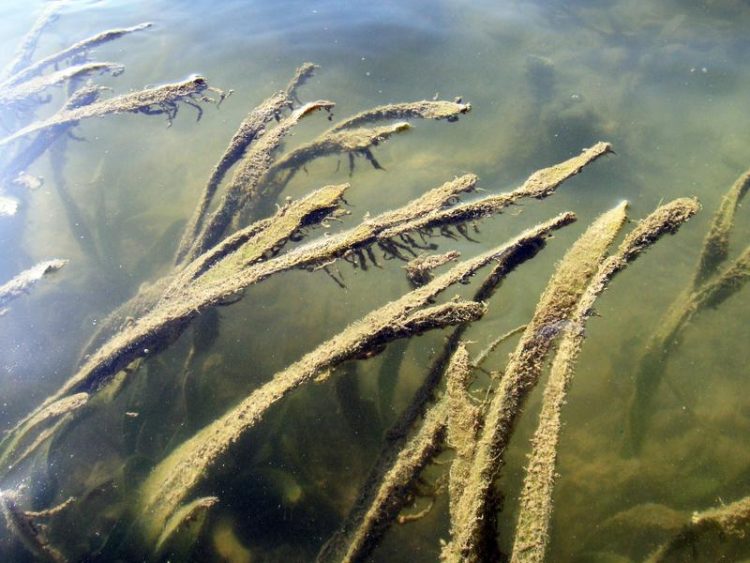Seagrass meadows at the limit

Small algae, which are fed by nitrogen-rich wastewater from aquaculture ponds, grow on the seagrass off the Chinese island of Hainan Lucia Herbeck, ZMT
Seagrass meadows grow in the shallow coastal seas and cover an area of almost 18 million hectares worldwide. Some years ago, scientists estimated the economic value of this habitat at 19,000 US dollars per year and hectare – more than twice as much as was attributed to mangroves, coral reefs or the tropical rainforest.
However, like other coastal ecosystems, seagrass beds are under severe threat from eutrophication of coastal waters and the progressing use and development of coastal zones.
For more than a decade, Tim Jennerjahn, biogeochemist at the ZMT, and his team have been researching seagrass beds off the island of Hainan in the South China Sea, which since the 1980s have been increasingly affected by wastewater from aquaculture plants.
The long period of time enabled the researchers to follow the slow decline of this ecosystem and to make precise statements about the influence of the nitrogen-rich wastewater from the breeding facilities.
“For the first time, we succeeded in determining a threshold value for nitrogen pollution above which the seagrass meadow habitat can no longer recover from this environmental stress and dies”, says Jennerjahn.
“It lies at a concentration of 112 micrograms of dissolved inorganic nitrogen per litre of water, which is effective for at least ten years.”
The number of aquaculture facilities, especially for shrimps and groupers, has increased explosively as a lucrative source of income throughout South East Asia in recent decades. In the research area at Hainan, more than 40 km² of breeding ponds with very high stocking densities line the coast.
Excess food and the excrements of the animals accumulate in the ponds, releasing a lot of inorganic nitrogen. The nitrogen-rich water from the ponds is discharged untreated into the coastal sea.
The researchers collected a large data set of more than 1,000 measured values at variously polluted sites in the seagrass meadows along the coast. This included data on the biomass and biodiversity of seagrasses, the amount of algae growth on the seagrass and the nutrient content in the water.
Since nitrogen can also enter the coastal sea through agricultural fertilizers and sewage from the hinterland, the scientists carried out an isotope analysis and were thus able to identify the breeding facilities as the main source of nitrogen input. The high nitrogen concentrations from the ponds stimulate the growth of phytoplankton and epiphytes – small algae that grow on the sea grasses. They shade the seagrass and hinder the vital photosynthesis.
“We were able to determine that 87% of the biomass of the seagrass beds disappeared in only ten years and their species richness decreased enormously under this chronic strain,” explains Esther Thomsen, biologist at the ZMT and first author of the study.
It is assumed that in the course of their evolution 100 million years ago, seagrass migrated from land back to the sea. Therefore it still shows typical characteristics of land plants, its closest relatives are the lilies. In contrast to algae, seagrass has a root system that provides it with a hold in the marine sediment. Seagrass meadows are found in the shallow water areas of the tropics, subtropics and temperate latitudes, including the Mediterranean, the North Sea and the Baltic Sea.
Seagrass meadows enrich their environment with oxygen and at the same time bind large quantities of the greenhouse gas carbon dioxide, more so than rainforests. They serve as nursery for a large number of edible fish and shellfish and are a food source for large marine animals such as turtles and manatees. With its roots, seagrass strengthens the sediment on the seabed and thus prevents coastal erosion.
“With our project we would like to contribute to the preservation of this valuable ecosystem and are therefore in close contact with decision makers and the general public on site. Among other things, we organise Citizen Science projects and training for aquaculture farmers to raise awareness of the problem,” reports Tim Jennerjahn. “With the concrete values for nitrogen pollution determined here, we can now also provide decision-making aids.”
Dr. Tim Jennerjahn
Leibniz Centre for Tropical Marine Research (ZMT)
Phone: 0421 / 23800-44
e-mail: tim.jennerjahn@leibniz-zmt.de
Esther Thomsen
Leibniz Centre for Tropical Marine Research (ZMT)
Tel: 0421 / 23800-79
e-mail: esther.thomsen@leibniz-zmt.de
Thomsen, E., Herbeck, L.S., Jennerjahn, T.C. (2020). The end of resilience: Surpassed nitrogen thresholds in coastal waters led to severe seagrass loss after decades of exposure to aquaculture effluents: Long-term aquaculture effluents exposure causes seagrass loss. Marine Environmental Research 160, 104986.
https://doi.org/10.1016/j.marenvres.2020.104986
Media Contact
More Information:
http://www.leibniz-zmt.deAll latest news from the category: Ecology, The Environment and Conservation
This complex theme deals primarily with interactions between organisms and the environmental factors that impact them, but to a greater extent between individual inanimate environmental factors.
innovations-report offers informative reports and articles on topics such as climate protection, landscape conservation, ecological systems, wildlife and nature parks and ecosystem efficiency and balance.
Newest articles

First-of-its-kind study uses remote sensing to monitor plastic debris in rivers and lakes
Remote sensing creates a cost-effective solution to monitoring plastic pollution. A first-of-its-kind study from researchers at the University of Minnesota Twin Cities shows how remote sensing can help monitor and…

Laser-based artificial neuron mimics nerve cell functions at lightning speed
With a processing speed a billion times faster than nature, chip-based laser neuron could help advance AI tasks such as pattern recognition and sequence prediction. Researchers have developed a laser-based…

Optimising the processing of plastic waste
Just one look in the yellow bin reveals a colourful jumble of different types of plastic. However, the purer and more uniform plastic waste is, the easier it is to…



